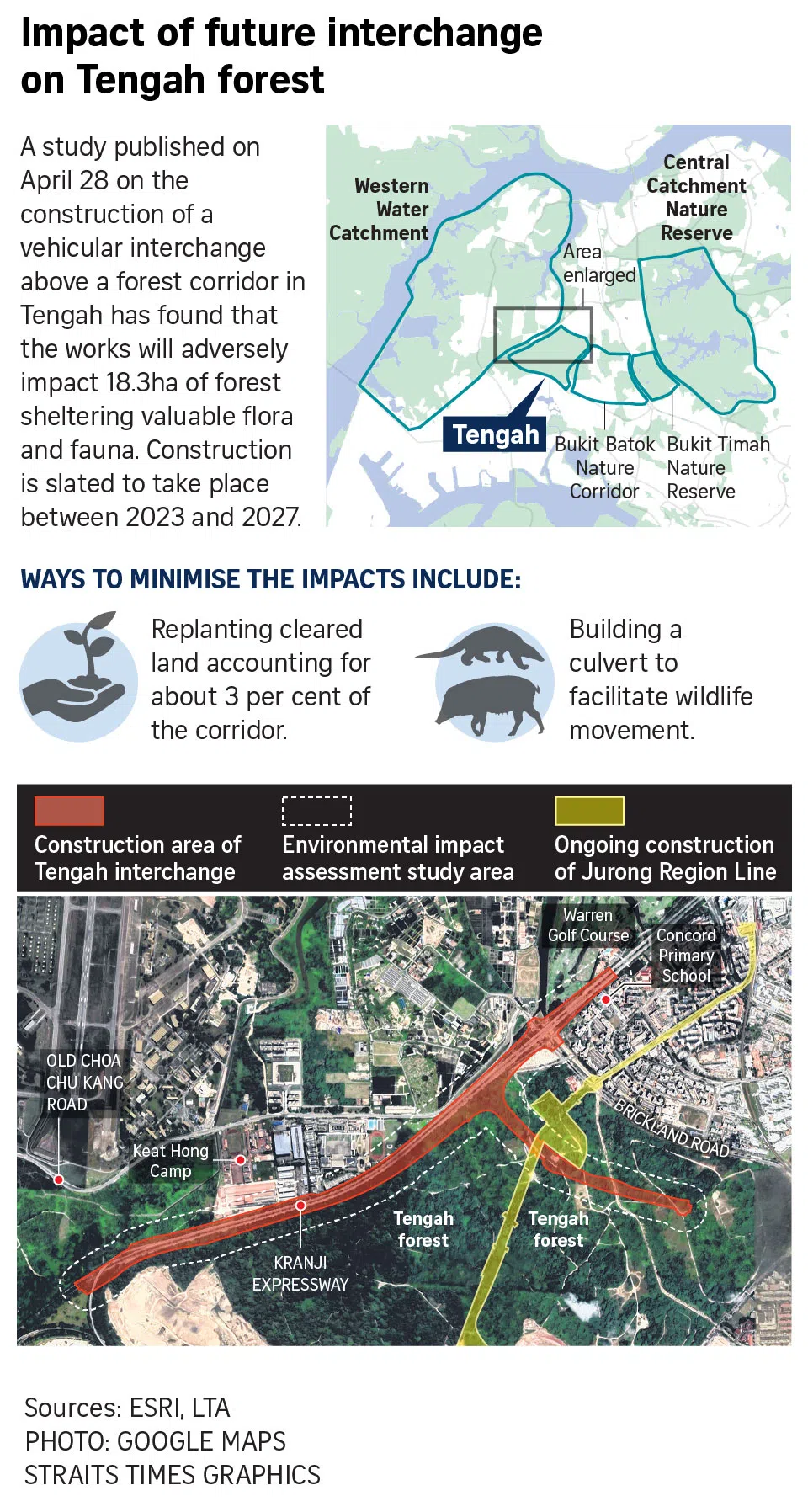Measures can reduce environmental impact of Tengah flyover project: LTA
Sign up now: Get ST's newsletters delivered to your inbox

Conservationists said the report’s inability to account for the impact of all work projects makes it difficult to anticipate whether the measures are sufficient.
ST PHOTO: LIM YAOHUI
Follow topic:
SINGAPORE - The construction of a traffic interchange, which will connect residents of the upcoming Tengah town to the Kranji Expressway (KJE), will likely have an irreversible impact on forest patches of high conservation value that cannot be mitigated, a recent report has found.
Clearance of about 22ha of forested land and vegetation to make room for the vehicular interchange is also expected to be detrimental to the national populations of 13 ecologically important plant species, and reduce the natural habitat for rare fauna like the harlequin butterfly and blue-eared kingfisher.
These were among the findings of an environmental impact assessment (EIA) commissioned by the Land Transport Authority (LTA) that was published on its website on April 28. The public had until last Friday to give feedback.
In 2020, the project drew flak for encroaching on a roughly 60ha forest corridor
The Housing Board previously set aside the 5km-long forest corridor within the upcoming Tengah town
LTA said nature groups have been engaged over the past year to review the anticipated impact of the flyover project and mitigating measures proposed by engineering firm CH2M Hill Singapore, which conducted the EIA.
The overall assessment was that the measures can bring these environmental impacts to “acceptable levels”, it added.
These measures include building a culvert – a structure that allows water to flow underneath a road from one side to the other – and temporary wildlife crossings to direct animals away from the construction area.
About 3 per cent of the forest corridor, or 1.8ha, cleared for the flyover will be replanted once works are completed, LTA said in response to queries.
When completed in end-2027, the Tengah vehicular interchange will consist of elevated roads leading to the KJE
Construction work is scheduled to start at the end of 2023.
The EIA had found that even with mitigating measures, a larger swathe of forest surrounding the project is likely to be negatively impacted by construction.
The report flagged the potential for accidental injury or death caused to wildlife by heavy machinery and vehicles used during construction, as well as the loss of ecological connectivity for animals like the critically endangered Sunda pangolin, which Singapore is a potential stronghold for.
Both direct and indirect major negative impacts are expected for 18.3ha of abandoned-land forest, which has a high abundance of plant and animal species that are of conservation significance, the report said.
The leopard cat and harlequin butterfly, which are both critically endangered here, and the nationally endangered smooth otter were among the fauna recorded in the affected abandoned-land forest habitat, half of which will be felled for the flyover.

(From left) The harlequin butterfly, the Sunda pangolin and the smooth otter.
PHOTOS: MAX KHOO/NPARKS, LIANHE ZAOBAO FILE, ST FILE
In particular, the report noted that the forest dwelling butterfly has been known to occur on mainland Singapore only at a formerly vegetated site in Cleantech Park in Jurong.
Dr Shawn Lum, former president of Nature Society (Singapore), which was one of the nature groups engaged, said: “Any time habitat size is reduced, the carrying capacity of the remaining habitat is reduced – fewer species can be supported, and fewer individuals of each species.”
As part of the effort to minimise loss of habitat and food for the harlequin butterfly, the report proposes that ecologists rescue any larvae found on plants in the cleared areas, and the planting of the insect’s host plant within a 30m by 5m vegetation patch in the site.
The report also stated one limitation – that it does not cover the overall Tengah Town development.
Conservationists said the report’s inability to account for the impact of all construction projects in Tengah forest and the surrounding green spaces makes it difficult to anticipate whether the planned measures will be sufficient to shield wildlife from development.
Dr Lum, who is also a senior lecturer at Nanyang Technological University’s Asian School of the Environment, said many animals in the survey may be dependent on a much larger area than the site covered in the EIA, as they are known to move around.
For instance, the ground-dwelling Sunda pangolin recorded in the project site requires connected habitats for dispersal so works and other ongoing developments will likely impact it.
Dr Lum said: “The question is thus how much of the wildlife captured in the survey will manage to persist in the greatly reduced nature corridor, and to use the linear strip of vegetation as their principal habitat.”
Ms Rachael Goh, from environmental group LepakInSG’s land use planning team, said that with the development of Tengah happening in phases and with different aspects managed by different agencies, the approach does not accurately map the impact of development on Tengah forest as a whole.
She said: “For example, a common mitigation action is to shepherd wildlife towards the centre of Tengah forest.
“While that may be sufficient for now, looking at the long-term development plan, the centre area is set to be developed for residential or commercial use?”

The group also called for measures to reduce conflict between humans and wildlife during and after construction, given plans to shepherd wildlife to adjacent forest and upcoming housing estate.
LTA said it is committed to undertaking all necessary mitigation measures and work with environmental consultants to implement a comprehensive Environmental Monitoring and Management Plan (EMMP).
It said: “We will further assess and strengthen the EMMP if needed, as the project progresses.”

